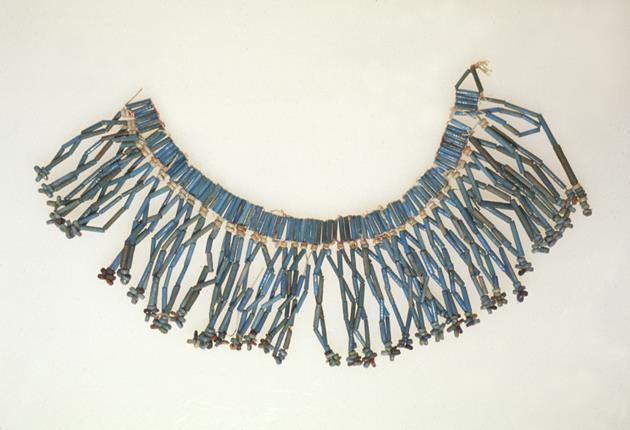Relief of Montuemhet and his wife Shepetenmut, ca. 665 B.C., Egyptian, 53.80
Echoes from ancient Egyptian dress appear in other parts of the African continent. Broad collars (weskhet) surrounded the necks of Egyptian men and women and statues of gods and kings. In this selection, the collars are seen on a lioness goddess, a cow eared goddess and a mayor and his wife. Weskhet were painstakingly strung with beads made from stones, metal and faience, and they were worn extensively from the sixth dynasty on. Wigs of braided and curled hair were kept in special chests and worn during ceremonial occasions.
No exact connections between ancient Egyptian jewelry and wigs and later examples in Africa have been established. Yet the Maasai, who migrated along the Nile to reach the east African savannah in the fifteenth century, have remarkably similar broad collars. Their braided hairstyles also resemble ancient Egyptian wigs and serve as a reminder that Egypt stands as a parent civilization whose depth of influence is still being discerned.
In this Egyptian work, a husband and wife are seated together and wear several elements that are reminiscent of Maasai adornment. Both wear heavily plated and striated wigs and wide collar necklaces. She carries a flywhisk that curls over near her husband's chin. Her dress has a plunging neckline with clasps at both shoulders.
Head of Hathor from the handle of a votive sistrum, ca. 664-525 B.C., Egyptian, 58.77
This ceremonial rattle is double-sided, with the image of the cow-eared goddess, Hathor, who wears a broad collar. Detailed linear patterning depicts the strands of beads that were gathered to create weskhet collars.
Collar from tomb of Hatshepsut, 15th century B.C., Egyptian, 44.28
Strands of ceramic beads create an openwork collar that derives from the New Kingdom.
Trading Art for Education
Americans roam through Maasailand on the safari circuit in large numbers. Maasai, on the other hand, rarely come to the United States. When Kakuta Hamisi came to study at Evergreen State College in Olympia, he ended his internship with a proposal designed to address the imbalance in the level of input Maasai had on presentations of their own aesthetics. He returned to his community with enough money to help start a school, and the community donated art for him to take back to the museum. This exchange took place in 1999 and resulted in a primary school filled with Maasai teachers. For the museum, the Maasai collection contains a range of art that a community of men and women chose to send to Seattle. For each object, the owner's name is noted and their transaction is recorded.
Maasai collection being presented to Kakuta Hamisi by members of the Kaputei section, 1999
Image courtesy of Samuel OrekaiOther Beadwork in SAM's Collection
Bracelet, n.d., Ghanaian, Asante, 81.17.428
Bowl, n.d., origin unknown, 81.17.492
Diviner's bag (Apo Ifa), n.d., Nigerian, Yoruba, 81.17.639
Cloak (Linaga & Nyoga), 20th century, South Africa, Transvaal, Ndebele, 81.17.1285
Crown (Ade), 19th-20th century, Nigerian, Yoruba, 91.251
Mask (Mukyeem), n.d., Congolese, Kuba, Bushong, 2001.44
Kalyeem hat, n.d., Congolese, Kuba, 2001.307
Kupash hat, n.d., Congolese, Kupa, 2001.311
Kupash hat with circular brass knob, n.d., Congolese, Kupa, 2001.314
Yet Belt, n.d., Kuba, 2001.329
Yet ornament, mask, n.d., Kuba, 2001.351
Necklace (Ngayook), n.d., Kuba, 2001.371
Photo: Paul Macapia
Apron, Cameroon, Kirdi, 20th century, 2004.108
Photo: Paul Macapia
Apron, Cameroon, Kirdi, 20th century, 2004.109
Photo: Paul Macapia
Apron, Cameroon, Kirdi, 20th century, 2004.110
Photo: Paul Macapia
Apron, Cameroon, Kirdi, 20th century, 2004.111
Photo: Paul Macapia
Apron, Cameroon, Kirdi, 20th century, 2004.112
What One Community Can Do
Since the school was established, it has grown in size and reach to accommodate more grades and more students. The Merrueschi community has established guesthouses for visitors, undertaken a water purification project and now utilizes resources on the Web to manage their interactions with people who visit Kenya and want to learn more about Maasai aesthetics and their world view.
Merrueshi Primary School, southeastern Maasailand, Kenya
Courtesy of Kakuta Ole Maimai HamisiHaving established the idea to trade support for a school for donations of Maasai art, Kakuta Hamisi faced some challenges. "I didn't want them to see me as the collector, but left it up to them to decide what would come. We did have problems. Forty or so women who are now Christian said they didn't want to give anyone devil objects, but they did want their children to go to school. Others pressured them to contribute and they did bring a calabash. All along, Samuel and I talked about how to keep this from being an issue that created individualism or became destructive for the community. During this time, the laibon [spiritual leader, prophet, and healer] came to visit. This doesn't happen often. While he visited, women sang Christian songs to protest his visit. He said he wouldn't confront them, that 'those are little things.'"
Portrait of Kakuta Hamisi, 2002
























